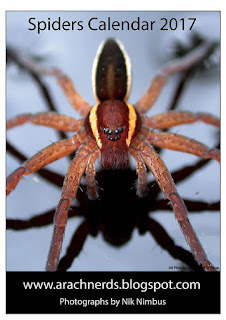Arachnerds
Amateur Spider Blog
Monday, 6 November 2017
Saturday, 14 October 2017
Spider Calendar in The Daily Express
Stuart Winter very kindly wrote an article in
The Daily Express, about my Spiders Calendar :
http://www.express.co.uk/news/nature/745579/spider-calendar-nik-nimbus-conservation-arachnophobes-british-arachnological-society
The Daily Express, about my Spiders Calendar :
http://www.express.co.uk/news/nature/745579/spider-calendar-nik-nimbus-conservation-arachnophobes-british-arachnological-society
Friday, 30 December 2016
Hogna lenta mating
Here is a short video of captive Hogna lenta (Lycosidae), mating.
The male is depositing sperm with his pedipalps.
The male is depositing sperm with his pedipalps.
Wednesday, 19 October 2016
Saturday, 15 October 2016
Sunday, 1 February 2015
Green Huntsman Spider - Micrommata sp
Micrommata sp
Family : Sparassidae
Genus : Micrommata
Sparassids lie in wait and grab passing prey. Mating begins with the male
gripping the female's leg or abdomen in his chelicerae, it can last up to seven
hours.
This photograph was taken by my good friend, Gary Bradley,
of UKSafari.com, on his barge in the North East of France. Gary tells me
that they are in abundance in the area.
Source : Spider Recording Scheme, Collins Field Guide to Spiders of
Britain and Northern Europe - Michael J. Roberts, Spiders of Britain and
Northern Europe - Dick Jones.
Micrommata sp - M. virescens or M. ligurina
Photograph by Gary Bradley
Moussey, France
September 2014
Family : Sparassidae
Genus : Micrommata
Sparassids lie in wait and grab passing prey. Mating begins with the male
gripping the female's leg or abdomen in his chelicerae, it can last up to seven
hours.
This photograph was taken by my good friend, Gary Bradley,
of UKSafari.com, on his barge in the North East of France. Gary tells me
that they are in abundance in the area.
Source : Spider Recording Scheme, Collins Field Guide to Spiders of
Britain and Northern Europe - Michael J. Roberts, Spiders of Britain and
Northern Europe - Dick Jones.
Micrommata sp - M. virescens or M. ligurina
Photograph by Gary Bradley
Moussey, France
September 2014
Sunday, 16 November 2014
Philodromus cespitum
Philodromus cespitum
Family : Philodromidae
Genus : Philodromus


Female Philodromus cespitum
Bevendean Down, Brighton, East Sussex
21.06.14
I found this spider on gorse at Bevendean Down, Brighton, East Sussex. It
appears to have a hitcher - a young Velvet mite. The mite feeds on the spider,
but does not harm it, as it will eventually drop off when approaching
adulthood.
"This is almost certainly the form which has an overall pale top surface to the
abdomen. Philodromus cespitum and others in the aureolus group are very
variable, and can't generally be identified from photos, and lots of
arachnologists have trouble even under a microscope, but this is the one
variety which is pretty certain".
Peter Harvey - British Arachnological Society
Family : Philodromidae
Genus : Philodromus
Known as the Turf running spider.


Female Philodromus cespitum
Bevendean Down, Brighton, East Sussex
21.06.14
I found this spider on gorse at Bevendean Down, Brighton, East Sussex. It
appears to have a hitcher - a young Velvet mite. The mite feeds on the spider,
but does not harm it, as it will eventually drop off when approaching
adulthood.
"This is almost certainly the form which has an overall pale top surface to the
abdomen. Philodromus cespitum and others in the aureolus group are very
variable, and can't generally be identified from photos, and lots of
arachnologists have trouble even under a microscope, but this is the one
variety which is pretty certain".
Peter Harvey - British Arachnological Society
Subscribe to:
Comments (Atom)






















